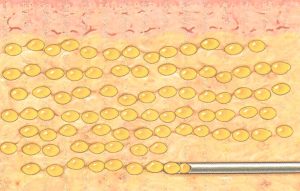- A permanent way of augmenting the breast shape and volume by transferring fat from another part of the body e.g. the abdomen or thighs.
- The fat is processed and injected under the skin (in the subcutaneous plane) of the breasts, and not into the actual breast tissue.
- The technique of injection is very crucial to the survival of fat. The fat is gently injected using multiple small 1 ml syringes depositing the fat in small aliquots (parcels). This ensures the largest surface area for maximal diffusion of nutrients from surrounding tissue and thus enhance survival of the fat cells.
- At least about 60-70% of the fat injected survive. These cells will permanently live in the injected site.
- The fat injected contain a small amount of patient’s own stem cells which helps to rejuvenate the skin.
- The amount of fat injected in each session should not be excessive. Otherwise the resultant swelling would reduce blood flow to the fat cells and thus lower their survival rate. Therefore multiple sessions of fat transfer may be needed to achieve the desired volume.
- Realistically each session of fat transfer can increase the breast volume by half to one cup size (75 – 150 ml)
- The survival of fat injected into the breast can be further enhanced by wearing the Brava Device.
- A device that uses a negative pressure to stretch the breast tissue
- It is worn for more than 10 hours day for at least 2-4 weeks after the fat transfer procedure
- This promotes better blood circulation within the breast tissue that helps fat survival
- Fat transfer to the breast generally does not affect breast feeding.
CONCURRENT PROCEDURES
- Patients undergoing liposuction of the abdomen and thighs may transfer the unwanted fat to the breasts
- Mummy makeover which consists of tummy tuck and breast augmentation. Fat transfer to the breast can be considered instead of breast implants.
- Fat transfers to face and breast concurrently.
SUITABLE CANDIDATES
- Patients who do not want augmentation using a foreign body.
- Sufficient fatty deposits in the abdomen or thighs.
- Willing to undergo more than one session of this procedure.
- Willing to accept less dramatic and instantaneous results.
- Suitable for :
- Tuberous breast..
- Mild breast deflation after breast feeding
- Widened cleavage post breast implant insertion.
- Breast contour deformity post breast cancer surgery reconstruction.
DESCRIPTION OF PROCEDURE
- Injection of tumescent fluid (to control bleeding) into fat donor site (abdomen and/or thighs)
- Fat is gently syringed out from the abdomen and/or thighs via well-hidden small cuts (less than 1 cm)
- Fat is processed using Coleman’s technique : Harvested fat is then centrifuged and separated into 3 layers : upper layer of free oil, middle layer of usable fat, and lower layer of water, blood and tumescent fluid.
 Fat Transfer Technique
Fat Transfer Technique- The usable fat is gently injected into the breast under the skin, using multiple small 1 ml syringes depositing the fat in small aliquots (parcels).
- The injection sites in the breast are well hidden in the areola.
- Duration of procedure (depending on complexity) : 1.5 – 3 hrs
ANAESTHESIA
- General anaesthesia
- Combination of local anaesthesia with intravenous sedation
POST OPERATIVE COURSE
- Home on the same day.
- Support bra for 1-3 months.
- Medication to reduce swelling and pain.
- Swelling, bruising and tightness over the breast for about 2 weeks.
- Sutures over the small injected sites are removed after 1 week.
- Light exercise from 3-4 weeks after procedure.
- Final results usually seen in approximately 3 months.
FINANCIAL COUNSELLING
- Fat transfer for the management of tuberous breasts or post breast cancer reconstruction may be considered as non-cosmetic.
RISK AND CAUTION
- The transferred fat that did not survive can result in a small amount of calcium deposits (macrocalcification) appearing in a mammography. This is different from microcalcification (which is indicative of breast cancer). Meticulous injection technique is important in preventing this.
- Fat injection does not increase the chance of breast cancer. Patients are often confused about this point.
After consultation, Dr Ng would guide you to decide on the best surgery for breast enhancement i.e. fat grafting (transfer) to breast or breast augmentation using implant. Structural fat grafting to the breast remains a top choice of some of the best plastic surgeons in Singapore and around the world.
